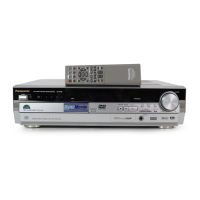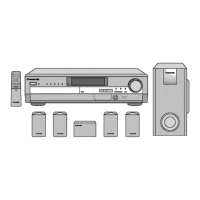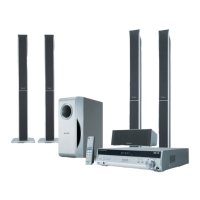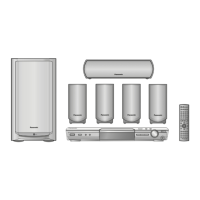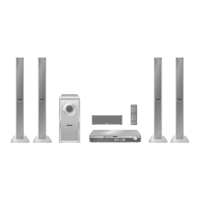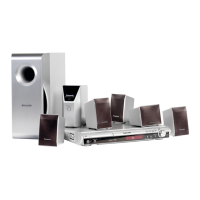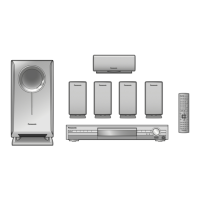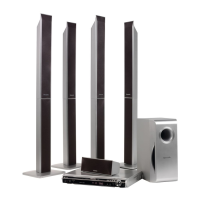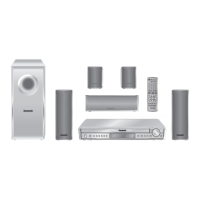Do you have a question about the Panasonic SC-HT280 and is the answer not in the manual?
Essential safety rules for power, polarization, cord protection, and non-use periods.
Proper setup concerning antenna grounding, placement, and environmental conditions.
Guidelines for cleaning the unit and information on seeking professional service.
Steps for connecting audio and video components to the receiver.
Instructions for physically placing and connecting the speakers.
Adjusting speaker distance and output levels for optimal surround sound timing.
Description of buttons, selectors, and indicators on the receiver's front panel.
Explanation of the receiver's display indicators and their meanings.
Proper methods for inserting and handling batteries.
Guidelines for optimal use and preventing damage to the remote.
Diagrams for connecting a TV and DVD player using various cables.
Instructions for connecting an optical fiber cable.
Wiring diagrams for connecting CD players, tape decks, and turntables.
Diagrams for connecting VCRs and other video devices.
How to connect AM loop and FM antennas, including indoor and outdoor types.
Instructions for connecting the power cord and info on the switched AC outlet.
How to identify and attach stickers to speaker cords for correct connection.
Detailed steps for connecting speaker cables to small and large speakers.
Diagrams and guidance for positioning front, center, surround, and subwoofer speakers.
How to connect speaker wires to the receiver terminals, including wall/stand mounting.
Initial settings for speaker size, distance, and filter.
Adjusting distance for front, center, and surround speakers.
Calibrating speaker output levels using the test signal for balanced sound.
Using stereo mode for stereo sources or down-mixing surround sources.
Automatic detection and processing of digital audio sources like Dolby Digital/DTS.
Sound Field Control modes (Hall, Club, Live, Theater, Sim Surr) for enhancing audio experience.
Choosing the desired audio/video source and activating speaker systems A or B.
Choosing desired Digital Signal Processor and Sound Field Control modes.
Setting the overall listening volume and fine-tuning individual speaker output levels.
Setting the delay time for surround channels.
Modifying bass, treble, and speaker balance for desired sound.
Controlling the subwoofer's volume and low-pass filter frequency.
Understanding the TAPE (MONITOR) indicator and using the tape monitor function.
Overview of radio reception and sequential tuning methods.
How to automatically scan for and tune to available stations.
Directly tuning to radio stations using frequency input via remote.
Storing and recalling radio stations using memory channels.
Automatically saving all receivable FM and AM stations.
Manually saving specific radio stations to memory channels.
How to select and listen to stored radio stations.
Muting the audio output and connecting headphones for private listening.
Compressing audio dynamic range for late-night or quiet listening.
Instructions for recording audio onto tape decks or VCRs.
Steps for recording audio from various sources onto a tape deck.
Steps for recording video and audio onto a VCR.
Basic operations for controlling the receiver with the remote.
Key functions like power, source selection, and mode selection.
Further receiver operations via remote control.
Using the remote for radio tuning and station selection.
Controlling cassette deck playback and functions with the remote.
Controlling CD player functions like playback, track selection, and skipping.
Instructions for watching TV through the receiver.
Using the remote to watch TV channels via a VCR.
Steps for viewing video tapes using the VCR and receiver.
Controlling DVD player functions, including playback and menu navigation.
Procedure for changing the remote's operating code for compatibility.
Details about using alternative speakers and impedance matching.
Guidelines for connecting and using speakers other than the included set.
Explanation of speaker status indicators on the display.
Configuring speaker size, distance, and filter settings for optimal sound.
Adjusting speaker size for optimal frequency response.
Calibrating speaker distance for accurate surround sound timing.
Adjusting the low-pass filter frequency for the subwoofer.
Using the HELP function to diagnose and resolve operation errors.
Advice on safe listening levels to prevent hearing damage.
Instructions for cleaning the unit and seeking professional service.
Technical details of the amplifier and tuner sections.
Technical details for the included front, center, surround, and subwoofer speakers.
Solutions for problems like hiss, noise, and distorted stereo in FM reception.
Solutions for problems like abnormal beats, hum, and interference in AM reception.
Troubleshooting tips for no sound from surround speakers or inability to select modes.
Solutions for common issues like power, sound, playback, and display errors.
Essential safety rules for power, polarization, cord protection, and non-use periods.
Proper setup concerning antenna grounding, placement, and environmental conditions.
Guidelines for cleaning the unit and information on seeking professional service.
Steps for connecting audio and video components to the receiver.
Instructions for physically placing and connecting the speakers.
Adjusting speaker distance and output levels for optimal surround sound timing.
Description of buttons, selectors, and indicators on the receiver's front panel.
Explanation of the receiver's display indicators and their meanings.
Proper methods for inserting and handling batteries.
Guidelines for optimal use and preventing damage to the remote.
Diagrams for connecting a TV and DVD player using various cables.
Instructions for connecting an optical fiber cable.
Wiring diagrams for connecting CD players, tape decks, and turntables.
Diagrams for connecting VCRs and other video devices.
How to connect AM loop and FM antennas, including indoor and outdoor types.
Instructions for connecting the power cord and info on the switched AC outlet.
How to identify and attach stickers to speaker cords for correct connection.
Detailed steps for connecting speaker cables to small and large speakers.
Diagrams and guidance for positioning front, center, surround, and subwoofer speakers.
How to connect speaker wires to the receiver terminals, including wall/stand mounting.
Initial settings for speaker size, distance, and filter.
Adjusting distance for front, center, and surround speakers.
Calibrating speaker output levels using the test signal for balanced sound.
Using stereo mode for stereo sources or down-mixing surround sources.
Automatic detection and processing of digital audio sources like Dolby Digital/DTS.
Sound Field Control modes (Hall, Club, Live, Theater, Sim Surr) for enhancing audio experience.
Choosing the desired audio/video source and activating speaker systems A or B.
Choosing desired Digital Signal Processor and Sound Field Control modes.
Setting the overall listening volume and fine-tuning individual speaker output levels.
Setting the delay time for surround channels.
Modifying bass, treble, and speaker balance for desired sound.
Controlling the subwoofer's volume and low-pass filter frequency.
Understanding the TAPE (MONITOR) indicator and using the tape monitor function.
Overview of radio reception and sequential tuning methods.
How to automatically scan for and tune to available stations.
Directly tuning to radio stations using frequency input via remote.
Storing and recalling radio stations using memory channels.
Automatically saving all receivable FM and AM stations.
Manually saving specific radio stations to memory channels.
How to select and listen to stored radio stations.
Muting the audio output and connecting headphones for private listening.
Compressing audio dynamic range for late-night or quiet listening.
Instructions for recording audio onto tape decks or VCRs.
Steps for recording audio from various sources onto a tape deck.
Steps for recording video and audio onto a VCR.
Basic operations for controlling the receiver with the remote.
Key functions like power, source selection, and mode selection.
Further receiver operations via remote control.
Using the remote for radio tuning and station selection.
Controlling cassette deck playback and functions with the remote.
Controlling CD player functions like playback, track selection, and skipping.
Instructions for watching TV through the receiver.
Using the remote to watch TV channels via a VCR.
Steps for viewing video tapes using the VCR and receiver.
Controlling DVD player functions, including playback and menu navigation.
Procedure for changing the remote's operating code for compatibility.
Details about using alternative speakers and impedance matching.
Guidelines for connecting and using speakers other than the included set.
Explanation of speaker status indicators on the display.
Configuring speaker size, distance, and filter settings for optimal sound.
Adjusting speaker size for optimal frequency response.
Calibrating speaker distance for accurate surround sound timing.
Adjusting the low-pass filter frequency for the subwoofer.
Using the HELP function to diagnose and resolve operation errors.
Advice on safe listening levels to prevent hearing damage.
Instructions for cleaning the unit and seeking professional service.
Technical details of the amplifier and tuner sections.
Technical details for the included front, center, surround, and subwoofer speakers.
Solutions for problems like hiss, noise, and distorted stereo in FM reception.
Solutions for problems like abnormal beats, hum, and interference in AM reception.
Troubleshooting tips for no sound from surround speakers or inability to select modes.
Solutions for common issues like power, sound, playback, and display errors.
| Brand | Panasonic |
|---|---|
| Model | SC-HT280 |
| Category | Home Theater System |
| Language | English |

